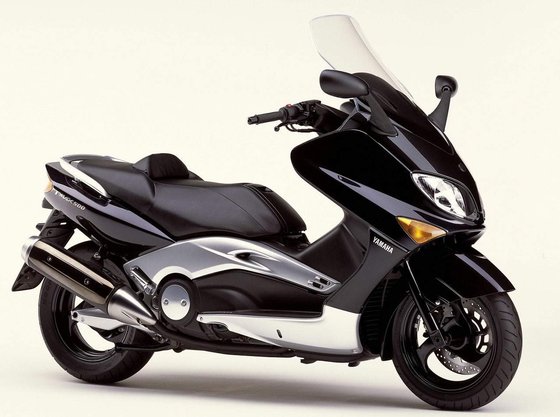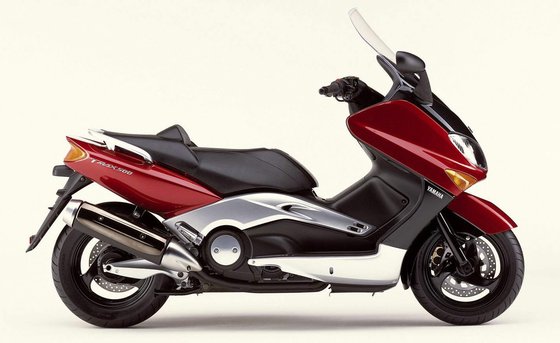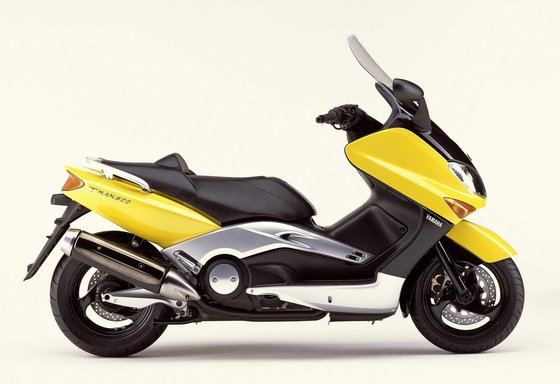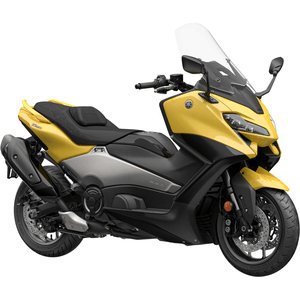Yamaha XP 500/530/560 T-MAX (2001–2003): The Original "Super Scooter" Revisited

Introduction
When Yamaha unleashed the T-MAX in 2001, it blurred the line between scooters and motorcycles. Dubbed the "Super Scooter," the T-MAX wasn’t just a commuter tool—it was a statement. Two decades later, this first-generation model (2001–2003) remains a benchmark for maxi-scooters. After a weekend test ride on a well-maintained 2002 example, it’s clear why the T-MAX became legendary. Let’s dive into what makes this machine tick—and why it still resonates with riders today.
Design & Ergonomics: Form Meets Function (Mostly)

The T-MAX’s design is unapologetically bold. From the front, it’s a "black-and-silver brick"—a towering fairing with a tall windscreen dominates the profile. While not sleek, it radiates purpose. The rear, however, is surprisingly elegant, with a streamlined tail and pearlescent silver accents.
Key Features:
- Storage: A hydraulic-strut-assisted seat reveals a cavernous 50L under-seat compartment (enough for two full-face helmets). The lockable fuel cap under the seat’s front flap adds security.
- Ergonomics: The 795 mm (31.3-inch) seat height is accessible, but the seat’s width makes flat-footing tricky for shorter riders. The wide handlebars and upright riding position feel motorcycle-like, not scooter-cramped.
- Practical Touches: A lockable glovebox (on the right fairing) and dash-mounted analog gauges keep essentials handy. Missing? A second glovebox—Yamaha left real estate unused.
Niggles: The stock windscreen creates helmet buffeting at speeds above 30 km/h (19 mph). At 180 cm (5’11"), I resorted to earplugs. An aftermarket shorter screen (available at MOTOPARTS.store) would solve this.
Performance: Twin-Cylinder Thrills

The heart of the T-MAX is its 499cc liquid-cooled parallel twin, a rarity in scooters even today. With 40 HP (29.2 kW) and 45.8 Nm (33.8 lb-ft) of torque, it’s a rocket compared to single-cylinder rivals.
On the Road:
- Acceleration: 0–100 km/h (0–62 mph) in 7.8 seconds—ahead of many 500cc motorcycles of its era. The CVT delivers seamless power, with no belt snatch. From stoplights, it embarrasses cars effortlessly.
- Top Speed: An indicated 160 km/h (99 mph) is achievable, though comfort fades above 130 km/h (81 mph). The engine vibrates noticeably at high RPMs, a trade-off for its character.
- Engine Braking: Close the throttle, and the T-MAX slows sharply—a trait borrowed from motorcycles, not scooters.
Fuel Efficiency: Expect 6.2–7.1 L/100 km (33–39 MPG), depending on throttle enthusiasm. The 15L (3.9-gallon) tank grants 200–250 km (124–155 miles) between fills.
Handling & Ride: Scooter Body, Motorcycle Soul
The T-MAX defies scooter stereotypes with motorcycle-grade dynamics:
- Chassis: A steel backbone frame and 14-inch wheels provide stability. The 1,580 mm (62.2-inch) wheelbase soaks up bumps but demands caution in tight traffic.
- Suspension: 38mm telescopic forks (120mm travel) and a rear swingarm (120mm travel) handle twisties with composure. Lean until the center stand scrapes—then lean some more.
- Brakes: Single 282mm front and 267mm rear discs lack ABS but offer strong, progressive bite.
Riding Experience:
- City: The CVT is flawless in traffic, though the T-MAX’s width limits filtering.
- Highway: Stable at 110 km/h (68 mph), but crosswinds nudge the tall fairing.
- Backroads: Shockingly fun. The Bridgestone Battlax tires (120/70-14 front, 150/70-14 rear) grip hard, and the low CG encourages knee-down antics.
Comfort & Daily Usability
Pros:
- Weather Protection: The fairing deflects rain and wind better than most motorcycles.
- Two-Up Readiness: Plush seating and integrated grab rails make pillions feel welcome.
- Storage: Groceries? Gym gear? No problem—the underseat bin swallows it all.
Cons:
- Vibration: The parallel twin buzzes through the bars and floorboards at highway speeds.
- Heat Management: In traffic, the liquid-cooled engine radiates warmth onto the rider’s legs.
Competition: How the T-MAX Stacks Up
The T-MAX’s rivals in 2001–2003 were few but fierce:
- Honda Silver Wing 600:
- Pros: Smoother 582cc engine, plusher seat, taller windscreen.
- Cons: Heavier (239 kg / 527 lbs), less agile, bland styling.
-
Verdict: Better for touring, but the T-MAX rules the twisties.
-
Suzuki Burgman 650:
- Pros: Electric screen, hydraulic center stand, class-leading comfort.
- Cons: Numb steering, ponderous weight (252 kg / 555 lbs).
-
Verdict: A luxury barge vs. Yamaha’s sporty contender.
-
Aprilia SRV 850:
- Pros: 839cc V-twin, 76 HP, thrilling acceleration.
- Cons: Unreliable electronics, limited dealer support.
- Verdict: A wildcard for speed demons—if you dare.
T-MAX’s Edge: Balance. It’s sportier than the Burgman, lighter than the Silver Wing, and more reliable than the SRV.
Maintenance: Keeping the T-MAX in Prime Shape
Key Service Points:
1. Engine Oil:
- Capacity: 2.9L (3.1 qt) with filter (SAE 10W-40, API SE+).
- Interval: Every 5,000 km (3,100 miles).
- Valve Adjustments:
- Intake: 0.15–0.20 mm (0.006–0.008 in) cold.
- Exhaust: 0.25–0.30 mm (0.010–0.012 in) cold.
-
Interval: Every 10,000 km (6,200 miles).
-
CVT Belt:
-
Inspect every 12,000 km (7,500 miles). Replace if cracked or worn.
-
Cooling System:
- Capacity: 2.4L (2.5 qt). Use ethylene glycol-based coolant.
-
Interval: Flush every 2 years or 30,000 km (18,600 miles).
-
Brakes:
- Fluid: DOT 4. Replace every 2 years.
- Pads: Check thickness monthly. OEM-style sintered pads recommended.
MOTOPARTS.store Recommendations:
- Spark Plugs: NGK CR7E (standard) or CR7EIX (iridium upgrade).
- Air Filters: High-flow options for improved throttle response.
- Windscreens: Aftermarket short/tall screens to customize airflow.
Conclusion: A Timeless Twist-’n’-Go Icon
The first-gen T-MAX isn’t perfect—its vibrations and wind buffeting grate on long hauls. Yet, it’s a pioneer that redefined scooters as credible all-rounders. For urban warriors craving weekend escape routes, it remains a compelling choice.
Today, well-maintained examples are rare gems. If you own one, MOTOPARTS.store has the upgrades and OEM parts to keep it thriving. From performance belts to ergonomic tweaks, we’ve got your Super Scooter covered.
Ride safe, and keep the rubber side down.
Specifications sheet
| Engine | |
|---|---|
| Stroke: | Four-stroke |
| Max power: | 29 kW | 39.0 hp |
| Max torque: | 46 Nm |
| Fuel system: | Carburetor |
| Max power @: | 7000 rpm |
| Displacement: | 499 ccm |
| Max torque @: | 5500 rpm |
| Bore x stroke: | 66.0 x 73.0 mm (2.6 x 2.9 in) |
| Configuration: | Parallel |
| Cooling system: | Liquid |
| Compression ratio: | 10.1:1 |
| Number of cylinders: | 2 |
| Valves per cylinder: | 4 |
| Dimensions | |
|---|---|
| Wheelbase: | 1580 mm (62.2 in) |
| Dry weight: | 197 |
| Seat height: | 795 mm (31.3 in) |
| Overall width: | 775 mm (30.5 in) |
| Overall height: | 1410 mm (55.5 in) |
| Overall length: | 2235 mm (88.0 in) |
| Ground clearance: | 140 mm (5.5 in) |
| Fuel tank capacity: | 15 L (3.9 US gal) |
| Drivetrain | |
|---|---|
| Clutch: | Wet, centrifugal clutch, cable-operated |
| Final drive: | V-Belt |
| Transmission: | CVT with wet multiplate centrifugal clutch |
| Maintainance | |
|---|---|
| Rear tire: | 150/70-14 |
| Engine oil: | 10W40 |
| Front tire: | 120/70-14 |
| Break fluid: | DOT 4 |
| Spark plugs: | NGK CR7E or NGK CR7EIX |
| Spark plug gap: | 0.8 |
| Final drive oil: | 700 ml SAE 80 GL-4/5 |
| Coolant capacity: | 2.4 |
| Forks oil capacity: | 0.8 |
| Engine oil capacity: | 2.9 |
| Engine oil change interval: | Every 5000 km or 2 years |
| Valve clearance (intake, cold): | 0.15–0.20 mm |
| Valve clearance (exhaust, cold): | 0.25–0.30 mm |
| Recommended tire pressure (rear): | 2.5 bar (36 psi) |
| Recommended tire pressure (front): | 2.25 bar (33 psi) |
| Chassis and Suspension | |
|---|---|
| Frame: | Backbone frame |
| Rear brakes: | Single 267 mm disc, 1-piston caliper |
| Front brakes: | Single 282 mm disc, 2-piston caliper |
| Rear suspension: | Swinging arm |
| Front suspension: | 38mm telescopic forks |
| Rear wheel travel: | 120 mm (4.7 in) |
| Front wheel travel: | 120 mm (4.7 in) |



















